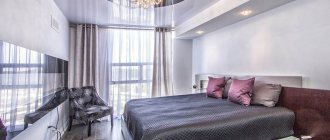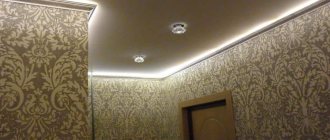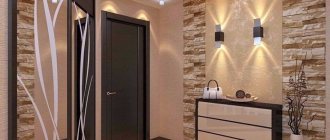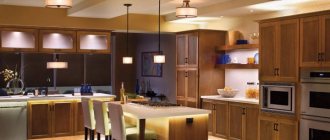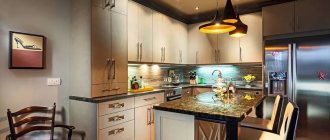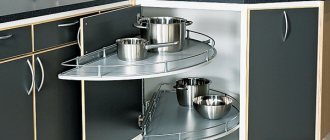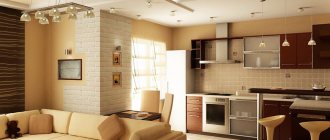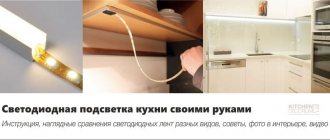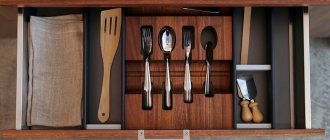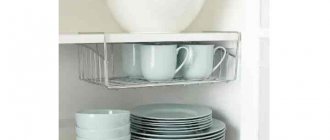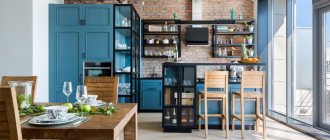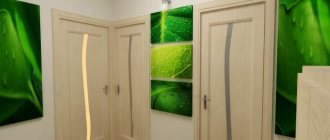The convenience and harmony of your kitchen depends much more on ceiling lighting than it might seem. It:
- creates the conditions necessary for preparing and eating food;
- emphasizes the ceiling design;
- separates the cooking area from the dining area;
- visually increases the size of the room;
- radically changes the atmosphere in the room and even affects your well-being.
The kitchen is a multifunctional room, and its lighting should be the same. To do this, we advise combining design and practical approaches, taking into account general recommendations, features of the kitchen and suspended ceilings.
A bit of useful theory
If you have not yet chosen the type of suspended ceilings, then here is a great article. Lighting design distinguishes 3 types of lighting, differing in their functionality:
- general – evenly fills the room with light and replaces daylight;
- accent - directs light to a particular object;
- decorative - illuminates the dining area, promoting a romantic mood or casual conversation.
Based on the location of the lamps on the ceiling, lighting is divided into central, spot and perimeter, symmetrical and asymmetrical. The names speak for themselves, so we won’t dwell on them, but will show examples in the photo.
But these types of lighting touch every room of the house. The kitchen dictates its own rules:
- the more light the better. More often we suffer from a lack, rather than from an excess of brightness in the kitchen. Therefore, when planning, think over a universal scheme consisting of different types of lighting - central and spot, wall, built-in furniture and ceiling. It will allow you to change the strength and direction of light flows. The photo shows successful examples of such schemes;
- lighting fixtures must have a high degree of protection and not be afraid of steam, grease and splashes.
Tension fabrics also have their vagaries:
- Consider the location of the lamps before installing the tension fabrics. They are installed on the base ceiling, and adding a light source can be problematic;
- the power of recessed luminaires for ceilings made of PVC film should not exceed 35 Watt, for fabric coverings - 50 Watt. The tendency of film panels to burn out and deform from high temperatures determines the power of the lamps and the direction of the lampshades;
- glossy canvases reflect light and double its amount, and dark ceilings require enhanced lighting.
Requirements
Since suspended ceilings are a fragile material, several rules must be followed when handling them. The main thing that the canvas is afraid of is temperature: at 55 degrees Celsius it begins to deform. Therefore, the lamp, if it is a spotlight, must have a side to prevent overheating. And there are requirements for the lamps themselves :
- halogen - up to 35 W;
- incandescent - up to 60 W.
Fluorescent and LED bulbs have no limitations, since they practically do not heat up. Therefore, it is advisable to use only them; in addition to safety, it is also more economical.
When using incandescent or halogen lamps, it is not advisable to choose lamps whose horns point upward. This will prevent the canvas from possible deformation due to heating and fading of brightness.
There is another difficulty with these light bulbs: you should choose the lamp itself more carefully, because the metal parts can also heat up and damage the canvas.
The conclusion is this: it’s better to use modern lamp options - and you won’t have to worry about anything.
Choosing types of lighting fixtures
In addition to performing basic functions, lamps must comply with (or at least not contradict) the parameters and general style of the kitchen, the design of the ceiling, create coziness and meet energy consumption requirements.
And here are the lighting devices you have at your disposal:
- pendant - chandeliers, lampshades, spots or just light bulbs on a cord;
- built into the ceiling - spots, panel, modular, spotlights;
- overhead – tablet lamps, spotlights, spots;
- LED Strip Light;
- ceiling-mounted monochrome or RGB lighting.
If you are thinking about decorative lighting for two-level structures, the effect of a floating ceiling and a starry sky would be interesting solutions.
The interior style and size of the kitchen will help you choose the appropriate type of lamp. It is desirable that the lighting fixtures match the decor, are made from the same material and do not differ in color. Similar lampshades can be found from different manufacturers.
Mixing styles is in fashion, so don’t be afraid to go beyond your chosen direction. Lighting should be comfortable, even if it turns a classic interior into a neoclassical one.
Now let's go through each of the points.
Zoning the kitchen with light
There are two main areas in the kitchen: dining and working. The latter sometimes consists of an island and a set against the wall. Typically, different lighting is selected for zones. This way their boundaries are emphasized. In addition, different levels of brightness are required for household chores and friendly or family gatherings.
A chandelier is often hung above the dining group. For a small kitchen, one lampshade is enough. It is convenient if the suspension on which it is mounted is lowered to different heights.
Above the cooking and dishwashing area, lighting is made from spotlights or LED strip. A spot system would look good in the area of the kitchen island. Depending on the size and shape of the table, a round or linear one is suitable. Another option is to place a light strip here.
Chandelier
This is one of the winning options for decorating a room with a suspended ceiling, the starting point of the entire light composition, which will provide general lighting. True, such a lamp does not look good in a small kitchen, and even with a low ceiling.
Chandeliers decorate not only classic interiors. They are appropriate in the styles of minimalism, hi-tech, retro, Provence, modern and are represented by a wide range of original lamps of regular and irregular shapes. The evidence awaits you in the photo below.
Idea: Want to create a unique ceiling accent? Decorate an inconspicuous chandelier with a fringe of threads, stones, beads, tetrapacks, glass, make shades from paper, wood or clothespins. Use materials that do not deform due to temperature, and remember to weigh the lamp down. Alternatively, first test how your chosen material will react by bringing it closer to the heat source.
The chandelier is placed exactly in the center of the ceiling, but in a spacious kitchen it can be shifted. It depends on the area chosen for lighting and the design of the ceiling. The larger the room, the greater the number of lamps needed for the chandelier. To illuminate a rectangular room or section of the ceiling, an elongated chandelier is suitable, and a round or semicircular tier will be decorated with a lamp of a similar shape.
Important: when planning kitchen lighting on paper or in online programs, find the exact center taking into account the kitchen unit - of course, if you do not plan to rearrange the furniture. Otherwise, it will seem that the chandelier is placed asymmetrically.
Do not forget about the sensitivity of film tension fabrics to heat.
Recommended standards differ for each type of lamp. To avoid damage to the canvas, you can use lamps with frosted glass for the chandelier. Another option to avoid this is to combine suspended ceilings with plasterboard, and install lighting in a more durable material.
Reviews about stretch ceilings
Based on reviews on the Internet, you can judge the quality of the selected product, since reviews are written by people who have already tested the new product for themselves.
Svetlana, Moscow
Before installing the ceiling in the kitchen, I was worried that I would have to remove all the previously installed furniture. But the craftsmen convinced me that you can leave everything in its place, so other objects will not be harmed when installing the stretch ceiling. The two-level structure took two days to install. When everything was ready, all that remained was to wash the floors and wipe the dust from the furniture.
I was afraid that steam and fumes could harm the canvas, but so far nothing has happened to it. For care I use a damp cloth, everything is washed easily and quickly.
Alexey, Voronezh
My husband and I live on the top floor, with only the roof on top. We decided to install a French stretch ceiling in the kitchen. Soon after the major renovation, we went on vacation for a month. When we returned, I was in for a shock! In the kitchen there was a huge bubble hanging from the ceiling. It turns out that while we were away, there were prolonged heavy downpours.
I had to call a craftsman to install the ceiling. They pumped out the water using the holes for the lamps and unfastened a piece of canvas. After drying, the fabric was stretched again; a small yellow spot remained in the place where there was water. I think it's a small price to pay to keep all your kitchen furniture intact.
You can find a lot of similar positive reviews about stretch ceilings on the Internet. Dissatisfied customers are also less common, but usually their dissatisfaction is associated with improper installation or poor-quality material used to make the canvas.
Hanging lampshade
A lampshade hanging from the ceiling is a wonderful way to create accent and decorative lighting in a large or medium-sized kitchen with a high ceiling. Hanging lampshades are best combined with spot or perimeter lighting, but together with a chandelier they will look good only in a large kitchen.
2-3 lamps located above the table with wooden or made from special paper lampshades are characteristic of the Scandinavian trend that is fashionable today. In the case of a kitchen layout with an island (peninsula), they are also placed above the work area. They look, you see, stylish and cozy.
Among the pleasant options is the ability to adjust the length of the cord and a wide variety of lampshades that can be changed from time to time, bringing variety to everyday life.
An interesting solution is a cage lampshade, suitable for kitchens in a modern style. And an Edison light bulb hanging on a cord or decorative knots will highlight interiors in a loft or retro style.
Spots
Super-functional modern lighting fixtures that can be easily directed to a particular area or object. There are suspended, overhead, built-in ceiling or furniture spots, with industrial, ordinary or sophisticated lampshades. For all this they are valued by designers.
Spots are suitable for huge spaces and kitchens in Khrushchev, and the variety of shapes and models gives them a green light in every interior direction. Decorate the metal crossbar with your own hands, as we advised in the case of the chandelier, and bring the spot closer to soft classic styles.
One such lamp will gently highlight a picture, niche or other accent detail of the interior, and several lamps will illuminate a spacious room.
Spots and spot systems are useful when rearranging furniture, because they will provide the right direction of light for cooking or eating. Examples of spots are waiting for you in the photo.
Panel and modular
For some, the ceiling lighting panel seems too industrial and more suitable for non-residential premises. And others will consider it a chance to create the illusion of a penthouse, attic or top floor of a private house with windows overhead. The panel lamp will fit into a kitchen in a loft, modern, or minimalist style.
The standard dimensions of panel lamps correspond to the parameters of kitchen modules - 60 x 60 cm, which will create proportionality that is easier for human vision to perceive. Light panels will provide diffused light. To make it uniform, install at least two such lamps. And this is what they look like.
Modular lamps themselves look a bit boring and are associated with an office. But if you connect them together - in a herringbone pattern, in a zigzag pattern, in geometric shapes in the middle or along the perimeter of the ceiling, you will be able to create an original lighting scheme.
Spot
These lamps are a gift for creative people. They illuminate a small area of space with a beam of light. Spot lamps:
- regulate light concentration;
- presented in different sizes, colors, shapes;
- create various lighting options;
- reflect light from glossy ceilings and disperse it evenly throughout the room;
- will visually increase the volume of the room (when placed around the perimeter);
- suitable for all interior styles with their simplicity and neutrality;
- the boundaries between kitchen areas are emphasized.
Spotlights can be built-in or overhead. They are easy to install - on the ceiling, walls, furniture, niches, providing uniform general and accent lighting. Spot lamps combine well with other lighting fixtures; they are used to create lines, arcs, circles, ovals, and other shapes.
Important: If the ceiling consists of several welded sheets, place spotlights at least 15 cm from the seam.
When using halogen lamps you will encounter so-called internal glare. The reflector in the lamp transmits part of the light into the canvas, exposing all its insides - wiring, fastenings, mountings for lamps and every speck of dust. An alternative is LED lamps.
LED lights
Used to illuminate all interior details, including the ceiling. White, yellow, colored, flashing, it is diverse and universal.
LED strips are so popular that we will not describe all the advantages in detail, but will simply show you them in the photo.
Important: a special box for the LED strip makes it safe for health.
One of the wonders achieved with LED lighting is the floating effect or floating ceiling. They are suitable for rooms of all sizes and will even raise ceilings.
Photos of suspended ceilings in the kitchen interior:
Next, look at the options for implementing suspended ceilings in ordinary apartments. We bring to your attention glossy and matte ceilings of various colors.
Having chosen a suspended ceiling, look at the modern ideas in kitchen design in the photo.
Ceiling lighting
Of all the possible options for such lighting, we will consider the most romantic - the “starry sky” ceiling. Well, who wouldn’t want to dine by candlelight under a sky strewn with stars, and even with planets or comets?
This effect is often done on PVC canvases, less often on fabric ones. And here are the ways to achieve it:
- photo printing;
- "star" optical fiber;
- these items + LED backlight;
- large LED dots;
- glowing Starpins pins;
- luminescent paint;
- scattering lenses from Swarovski.
All you have to do is choose the appropriate option and sacrifice 10-15 cm of ceiling height.
As you probably already guessed, it is better to use a combination of several types of lamps in the kitchen.
Additional lighting
In a small kitchen (for example, in a Khrushchev-era apartment), it is not necessary to hang a chandelier over the dining table. A wall sconce will be enough. This option will also save space in height.
It is useful to add lighting in the cabinets. This makes it more convenient to search for the necessary products or utensils, especially if they turn on automatically when you open the doors. And with a glass facade, additional lighting will appear, emphasizing the beautiful service.
Not an easy idea to implement, but a useful idea - dim lighting near the ceiling. It will help you navigate in the dark. To do this, lay a diode strip or build small point devices into the baseboard.
Useful tips
And finally, some recommendations:
- 1. Place the lamps above the work area, but not too far from the wall - so that the shadow of your head does not fall on the tabletop. The recommended distance between the lamp and the wall is 40-50 cm. Please note that other interior elements block the light.
- 2. There are formulas that help calculate how many light bulbs are needed to fully illuminate a room. For example, 5 watts of LED power is enough to illuminate 1 m2. So, in our case, it’s not scary to overdo it with lamps.
- 3. Are you familiar with the concept of color temperature? It is indicated in the parameters of the lighting fixtures and tells you what kind of light they emit - cold (2500-400 Kelvin) or warm (4000-5000 K). Cold lighting invigorates, warm lighting relaxes and creates coziness. Some lamps must be replaced, but in the case of LED lamps it is impossible to change the color temperature. Therefore, decide on this parameter in advance.
- 4. It is desirable that the available light sources approximately correspond to the same color temperature, and the difference between them does not exceed 500 K.
- 5. Lamps with warm light look advantageous on walls of cool colors, and vice versa.
With this we will say goodbye. We wish you bright and original ideas!
What to choose for which style?
After the main light sources have been sorted out, it’s worth talking about which ones will suit which style.
Country/Provence
The room should be bright and airy, the light should be soft and not glaring, not too intense. Lamps should be chosen with a warm tint, and lamps should be chosen in pastel shades of white, blue, pink, yellow. Motley and bright colors will not go well with such a kitchen. Chandeliers are chosen in interesting shapes, finished in bronze or silver, decorated with candles, stucco or flowers.
These styles welcome natural motifs, so it is better to choose lamps made of glass; plastic will not work, as will modern lighting systems such as spot systems and LED lamps. But sconces and table lamps are actively used.
Classic style
The classic style sticks to light colors, so the light should be bright, but soft. Typically, luxurious chandeliers with crystal or glass pendants are used as central lighting, and sconces, floor lamps and table lamps are used as lighting for functional areas.
The downside is that such lighting will require regular cleaning due to the accumulation of dust, so there are more and more kitchen designs in a classic style, but with LED strip lighting around the perimeter or spotlights along the walls.
The classic style loves symmetry, so there should be no question of how to position the spotlights - they are mounted symmetrically .
When choosing the main chandelier, you should focus on the scale of the room - everything should be proportional. In terms of color solutions, it is better to give preference to light tones; small bright details are acceptable.
